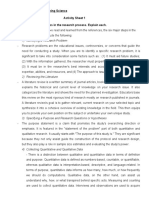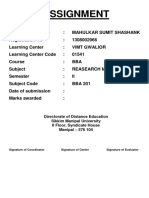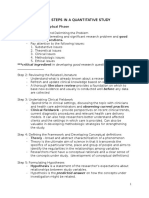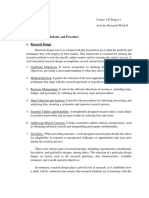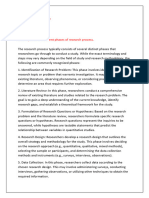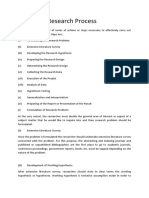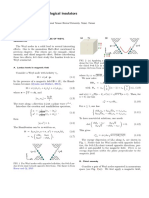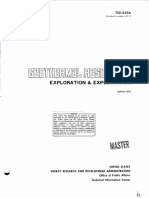0% found this document useful (0 votes)
64 views8 pagesQuantitative Research Process Phases
This document provides an overview of the key phases in the quantitative research process:
1) The conceptual phase involves identifying research questions, reviewing literature, defining variables, and developing a framework. It establishes the foundation and direction for the study.
2) The design and planning phase transitions to developing a concrete research plan, including selecting a research design, study population, data collection methods, and ensuring ethical considerations.
3) The empirical phase implements the research plan by collecting data according to the methodology through activities like participant recruitment, data collection, and quality assurance. Each phase is crucial for successfully completing a quantitative research study.
Uploaded by
ririkamobami259Copyright
© © All Rights Reserved
We take content rights seriously. If you suspect this is your content, claim it here.
Available Formats
Download as DOCX, PDF, TXT or read online on Scribd
0% found this document useful (0 votes)
64 views8 pagesQuantitative Research Process Phases
This document provides an overview of the key phases in the quantitative research process:
1) The conceptual phase involves identifying research questions, reviewing literature, defining variables, and developing a framework. It establishes the foundation and direction for the study.
2) The design and planning phase transitions to developing a concrete research plan, including selecting a research design, study population, data collection methods, and ensuring ethical considerations.
3) The empirical phase implements the research plan by collecting data according to the methodology through activities like participant recruitment, data collection, and quality assurance. Each phase is crucial for successfully completing a quantitative research study.
Uploaded by
ririkamobami259Copyright
© © All Rights Reserved
We take content rights seriously. If you suspect this is your content, claim it here.
Available Formats
Download as DOCX, PDF, TXT or read online on Scribd
/ 8


